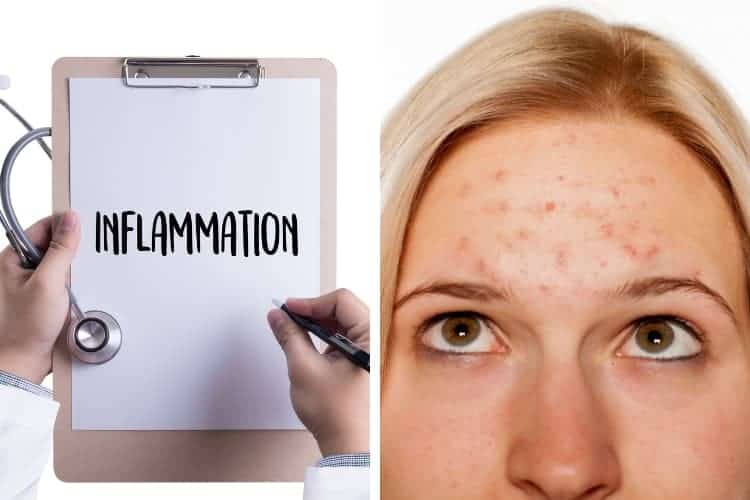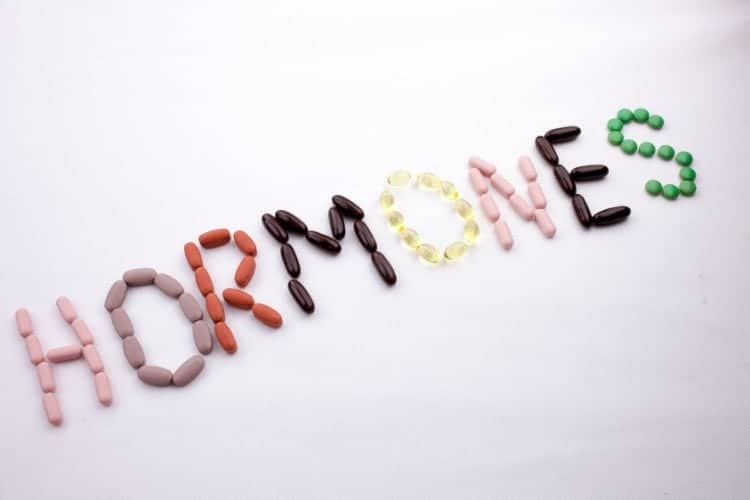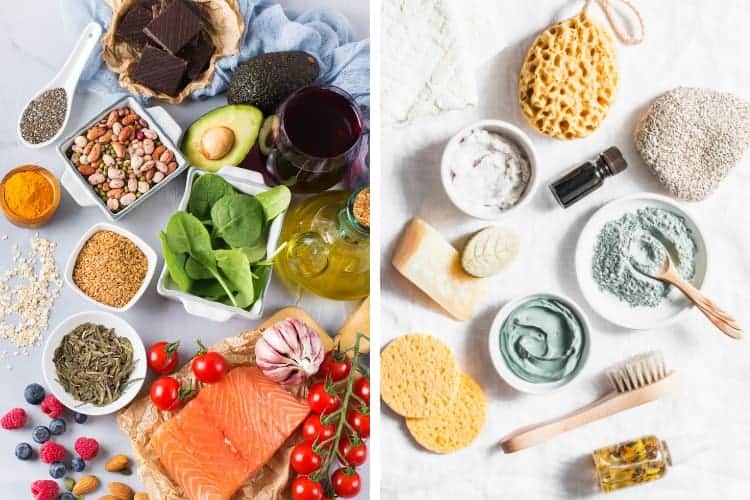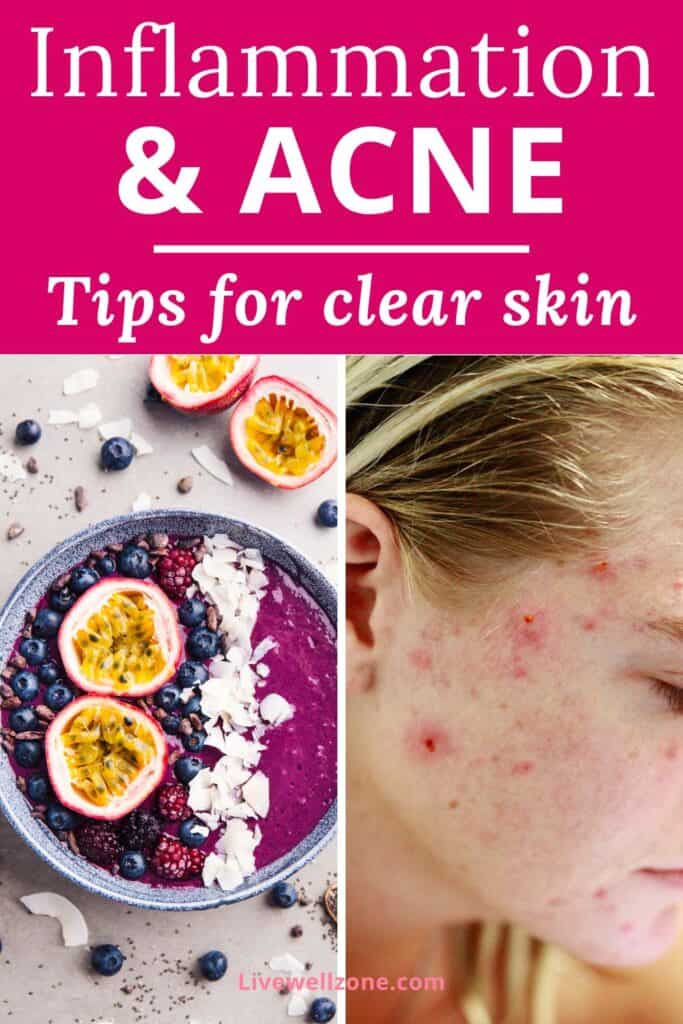
At this point there’s more and more agreement in the scientific community that acne is an inflammatory condition (1, 2, 3, 4).
So, you could stop reading this article right now because you already have the answer to the question “does inflammation in the body cause acne?”
But…what exactly is inflammation? What triggers it? And why does it end up causing acne?
Having the answers to these additional questions will give you a clear understanding of how acne develops, and that will ultimately make it easier for you to confidently clear up your skin.
So, without further delay let’s kick things off by discussing what inflammation is and its effects on the skin.
HOW INFLAMMATION AFFECTS THE SKIN

At the simplest level, inflammation is a natural process that the body relies on to protect itself from danger or stress (source).
So, the first thing to note here is that even though inflammation is often portrayed as enemy #1, it’s actually essential for our survival.
Now, when it comes to the danger or stress that triggers inflammation it can come from various sources: For example:
- Pathogens (viruses, bacteria and fungi), toxins in food, water or beauty products or refined/processed foods. These are known as chemical stressors.
- Working multiple jobs, feeling overwhelmed from social and family commitments, worrying about finances, caring for a loved one who’s sick, etc. These are known as emotional stressors.
- Dislocating a knee, pulling a muscle or an open wound. These are known as physical stressors.
Basically, anything that throws the body off of its natural state of balance, will add stress on the body and can be detrimental (either short or long-term) to the body.
And as the body is exposed to all those stressors, it protects itself by activating the inflammatory response system, aka the fight-or-flight system.
This response system mainly involves:
- the immune system.
- the HPA axis.
Now, explaining the intricacies of the inflammatory process would take forever (after all, some people spend decades simply studying it!). So, for the sake of simplicity, we’re going to focus our discussion mainly on the HPA axis.
THE UNIQUE LINK BETWEEN THE INFLAMMATORY RESPONSE SYSTEM AND ACNE
The inflammatory response system (aka the HPA axis) is the main pathway in the body that regulates our response to all the different types of stressors that we’re exposed to.
This axis involves the hypothalamus, pituitary and adrenals…which are all hormone-producing glands.
So, as the body is exposed to a stressor these glands adjust the amount of hormones that they secrete.
And one of the most significant changes that occurs when the HPA axis is activated is that the adrenal glands produce more cortisol.
Now, why cortisol? Simply because it’s a natural anti-inflammatory hormone.
Now, ideally, the release of cortisol is meant to last only a short while (a few minutes or even a few days if needed).
However, where things start to go haywire for the skin is when stress and cortisol stay high for an extended period of time. Here’s an overview of a few things that can happen in the body (source):
- Sebaceous glands in the skin – which happen to have receptors for cortisol – start to produce more sebum in response to high cortisol.
- Blood flow to the gut naturally declines as stress increases. With less blood flow to the gut, your body is now working at a deficit, which further worsens stress. And more stress leads to more inflammation, more cortisol and more sebum production. Basically, a vicious cycle!
- When stress/cortisol is high we need more glucose as a source of energy. The liver is the organ that ends up supplying that extra glucose. At the same time, cortisol also makes our cells more resistant to insulin (resulting in more glucose in the blood). As insulin levels increase this can lead the ovaries to make more testosterone (source). And unfortunately, this increase in testosterone can further worsen acne.
Once again, everything above is a very simplified overview of the many ways in which inflammation leads to acne.
But the whole point here is that inflammation is the underlying thing that sparks a series of reactions that lead to acne.
Understanding this means that ideally, we should address that underlying cause, in order to get rid of acne for good.
Now, you may be wondering about other common acne culprits – like clogged pores and bacteria – and where they fit into all of this.
Well, a bacterium known as propionibacterium acnes (or p. acnes), is most often linked to acne. This bacterium is normally part of our skin’s ecosystem and is harmless. However:
- A 2016 study showed that when p. acnes doesn’t get enough oxygen – which can happen as sebum accumulates in our pores – then it converts sebum into fatty acids (5, 6).
- Those fatty acids end up deactivating enzymes that would normally slow down inflammation on the skin.
- P. acnes also gather into a clump and place a protective barrier – known as a biofilm – around themselves. That biofilm cannot be penetrated by standard cleansing products, which means the bacterium can go on causing more pimples.
- When there are conditions that trigger excess sebum production, p. acnes continues to feed off of that sebum, which then triggers even more inflammation, and once again, there’s a vicious cycle set in place.
So, while it may seem like the bacteria alone causes acne, it’s actually more of a contributing factor that is exacerbated by inflammation.
SO, IS ALL ACNE A SIGN OF CHRONIC INFLAMMATION?
All acne is not automatically a sign of chronic inflammation. Sometimes breakouts may show up temporarily, as a result of an immediate stressor (be it emotional or another type).
However, if you have zits that show up repeatedly (let’s say around the time of your menstrual cycle) or if they sometimes get better with new products, but then return with a vengeance, or they just don’t improve no matter which products you try, then that’s a stronger indication of chronic, systemic inflammation.
Do keep in mind that acne is just one of the ways in which internal inflammation is reflected on the skin.
Other external signs of inflammation include hives, eczema, psoriasis and rosacea.
DIET AND LIFESTYLE TIPS TO LOWER INFLAMMATION AND CLEAR UP YOUR SKIN

Since inflammation is triggered by different types of stressors, the best way to improve it is to assess all aspects of your diet and lifestyle.
Although this is the best way, it’s not always quick or easy. In fact, it takes dedication, patience and compassion for yourself. Because there will be days when you feel like giving up. But if you can remind yourself that you are worth your own time, effort and commitment, then you can keep pushing through.
1. Adopt A (Mostly) Plant-Based, Anti-Inflammatory Diet
Dietary changes are not fun. But at the end of the day, the food you eat gives the body all the building blocks that it needs to keep your skin healthy.
Now, when it comes to what an anti-inflammatory diet is, it’s mainly:
- plant-based.
- focused on lean proteins (plant proteins and fatty fish).
- low in (or completely void of) of most meats, especially red meat.
- full of natural fats.
- very low in (or completely void of) animal products.
- loaded with plenty of herbs and spices (fresh or dried).
- very low in (or completely void of) processed foods and drinks (including healthier alcohols like wine).
- free of common allergens like GMO soy, GMO corn, dairy, gluten, shellfish.
- free of refined cane sugar artificial sweeteners.
So, with all those restrictions, what exactly are you able to eat for an anti-inflammatory diet? Here’s an overview:
- legumes (chickpeas, lentils, red/black/white beans).
- fresh or frozen vegetables , including leafy greens, cruciferous vegetables, organic corn and root vegetables and so on).
- gluten-free grains like rice, quinoa, teff, amaranth, buckwheat and so on.
- non-wheat pasta made from quinoa, brown rice, or organic corn.
- plant-based milks like almond or oat milk.
- pasture-raised eggs (if you’re not allergic to eggs).
- natural sweeteners like raw honey, pure maple syrup or whole leaf stevia.
- natural fats like raw nuts/seeds, avocados and coconuts.
- any herbs and spices you like, with particular attention on things like turmeric, ginger and cinnamon which are known to bring down inflammation.
- fermented foods and drinks like sauerkraut, kimchi, kefir or kombucha.
- herbal teas like spearmint and chamomile, both of which can be very helpful for acne.
- antioxidant-rich teas like green tea.
2. Clean Up Your Beauty and Personal Care Products
Everything from lipstick to shampoo and tampons contains chemicals that can contribute to inflammation.
Some people are particularly sensitive to these chemicals and their inflammation doesn’t improve unless they remove those products from their daily life.
The good news is that these days there are plenty of clean products to choose from for all aspects of personal care and beauty. And you can even make your own if you want full control over the ingredients.
However, depending on how many products you normally use, switching to cleaner products can be a tedious process.
3. Find Ways To Lower Emotional Stress
While we can’t always change undesirable life circumstances immediately, we can find ways to minimize the impact of those circumstances.
That’s where things like exercise, meditation, journaling and overall self-care comes into play. Making time to take care of yourself helps you to de-stress and ultimately, lower the amount of stress that your body has to handle.
And while you’re at it, sleep is part of this equation too. It’s less important whether you’re sleeping 5 hours or 9 hours. What’s more important is that you’re getting the right amount for you.
Not only can self-care help to improve the quality of your sleep, but herbal remedies – such as ashwagandha, chamomile and catnip – are often used by herbalists to improve sleep. And the more rest you get, the less stress and inflammation you’ll have to deal with.
Plus, those sleeping hours is when the skin, and the rest of your body, gets to repair itself!
FAQs ABOUT CHRONIC INFLAMMATION AND ACNE
What does inflammatory acne look like?
Inflammatory acne appears red and swollen (in contrast to non-inflammatory acne which can be either blackheads or whiteheads). Now, please note that the terms inflammatory and non-inflammatory acne refer to the physical appearance of the pimple (not systemic, internal inflammation).
In addition to looking red and swollen, inflammatory acne is broken down into the sub-types shown below (7, 8):
| Type of pimple | Description |
|---|---|
| Papules | Small reddish or pink-toned bumps. Can feel sensitive when touched. |
| Nodules | Large/wide bumps that feel firm. Often painful to the touch and can leave scars. |
| Pustules | Similar in appearance to whiteheads, but with redness around the bump. Usually filled with pus and can lead to scarring. |
| Cysts | Largest type of acne. They form deep within the skin. Usually quite painful and most likely to leave scars. |
How do you know if you have inflammation in your body?
Some of the tests that doctors use to detect inflammation include (source):
- SPE (serum protein electrophoresis) Test: this is considered the best and it measures the levels of certain proteins in plasma (the liquid part of blood).
- CRP (C-reactive protein) Test: CRP is a protein that the liver produces when there’s inflammation. So, high CRP is another way for your doctor to confirm the presence of inflammation.
- ESR (erythrocyte sedimentation rate) Test: This test looks at how quickly or slowly red blood cells sink in blood. The faster they sink, that’s an indicator of inflammation.
- Plasma Thickness: This test relies on the thickness of blood as a way to diagnose inflammation (plasma is said to thicken when there’s inflammation in the body).
Although these tests confirm that there is a problem, they’re not specific enough to tell us where exactly in the body the problem is located. So, it can be helpful to do other testing – such as a hormone test – to get a better idea of what’s going on with your body.
CONCLUSION
Short-term inflammation that only lasts a few minutes or days is unlikely to cause a really serious outbreak of zits. However, chronic, long-term inflammation is definitely concerning because of its effects on hormones and sebum production.
So, if you’ve tried many of the classic remedies for acne – i.e. topical products or even antibiotics – but haven’t seen much improvement, then it’s definitely worth taking a closer look at inflammation and how it could be contributing to your breakouts.

You Might Also Enjoy:
Seed Cycling for Acne: Benefits and How To Get Started
10 Teas for Acne-Prone Skin (for internal and topical use)
How Much Water Should I Drink To Get Rid Of Acne? The Answer May Surprise You
How To Make The Best Anti-Acne Smoothie To Give Your Skin New Life
Peppermint Tea vs Spearmint Tea for Acne: Which Is Better?
Why Is My Skin Bad When I Eat Healthy? 8 Reasons You May Not Have Considered

